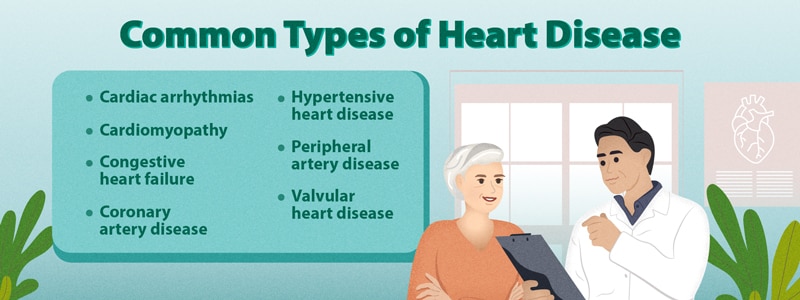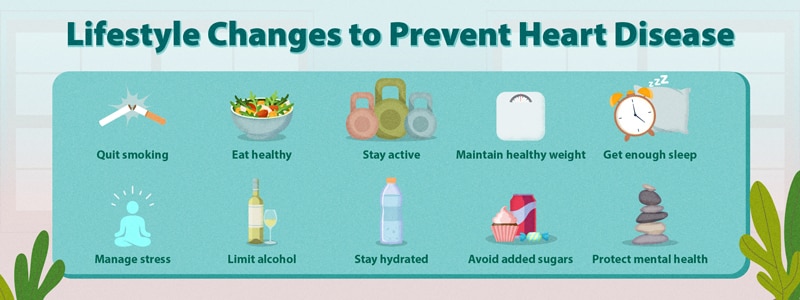Heart disease has been the leading cause of death in the United States for over a century, yet more than half of surveyed U.S. adults are unaware of this fact, according to a report from the American Heart Association.1 Raising awareness can help inform more people about this issue, which may provide them with a better understanding and prompt them to action.
On a personal level, this means learning how heart disease may affect your body and what can be done. For instance, high blood pressure and high cholesterol are two of the most significant contributors to heart disease, but it’s possible to manage these conditions with lifestyle changes and medical care.2
If you're uncertain where to begin, this guide can offer actionable advice to help you support your heart health and embrace a healthier lifestyle.
What Is Heart Disease?
Heart disease, also called cardiovascular disease, refers to a group of conditions that affect the heart and blood vessels. The most common type of heart disease is coronary artery disease, which occurs when the arteries that supply blood to the heart become narrowed or blocked.3
Types of Heart Disease

Heart disease encompasses a variety of conditions that affect the heart and blood vessels. Each type of heart disease has unique causes and effects, but many are linked to high blood pressure, high cholesterol and lifestyle factors.3 Some common types of heart disease are:
- Coronary artery disease
- Cardiac arrhythmias
- Valvular heart disease
- Cardiomyopathy
- Hypertensive heart disease
- Peripheral artery disease
- Congestive heart failure
1. Coronary artery disease (CAD)
Coronary artery disease is the most common type of heart disease.3 It occurs when plaque — made up of cholesterol and other substances — builds up in the arteries that supply blood to the heart.4 This buildup, called atherosclerosis, narrows the arteries and reduces blood flow, which can lead to chest pain (also called angina), heart attacks or other complications.4
2. Cardiac arrhythmias
Arrhythmias are irregular heartbeats that occur when the electrical signals controlling your heart’s rhythm don’t work properly. These can range from harmless to life-threatening.4
3. Valvular heart disease
Heart valve disease occurs when one or more of the heart’s valves don’t open or close properly, disrupting blood flow. This can be caused by high blood pressure, infections or other heart conditions.4
4. Cardiomyopathy
Cardiomyopathy is a disease of the heart muscle that makes it harder for the heart to pump blood. It can be caused by high blood pressure, genetic factors or other underlying conditions. Lifestyle changes, such as maintaining a healthy weight and managing cholesterol, can help reduce strain on the heart.4
5. Hypertensive heart disease
Hypertensive heart disease develops when high blood pressure is left untreated for years. Over time, the heart has to work harder to pump blood, which can lead to thickened heart walls, heart failure or other complications. High blood pressure also damages arteries, increasing the likelihood of heart attacks and strokes. Regular monitoring and lifestyle changes, such as reducing sodium intake and staying active, can help manage blood pressure and protect your heart.5
6. Peripheral artery disease (PAD)
Peripheral artery disease occurs when plaque builds up in the arteries that supply blood from the heart to the limbs, especially the legs. This condition is closely linked to high cholesterol and high blood pressure, which damage blood vessels throughout the body. PAD can cause pain, numbness or even mobility issues if left untreated.6
7. Congestive heart failure (CHF)
Congestive heart failure, often referred to as heart failure, is a chronic condition in which the heart cannot pump blood effectively enough to meet the body’s needs for oxygen and nutrients. When the heart’s pump weakens, blood and fluids can back up into the lungs, legs and other parts of the body. This can cause symptoms like shortness of breath, swelling or edema in the legs and feet, fatigue and difficulty exercising. While CHF is a serious condition, it can often be managed with a combination of medications, lifestyle changes and, in some cases, medical procedures. Treatments aim to improve symptoms, slow the progression of the disease and enhance quality of life.7
Symptoms of Heart Disease by the Numbers
Your heart health can often be measured by key numbers that provide insight into how well your heart and blood vessels are functioning. These metrics — such as blood pressure, cholesterol levels and body mass index — are essential for assessing your heart health and guiding treatment. When you understand these numbers, you can often take proactive heart health steps.
High blood pressure or hypertension
Blood pressure measures the force of blood pushing against the walls of your arteries. It’s recorded as two numbers: systolic pressure (the top number) and diastolic pressure (the bottom number). A normal blood pressure reading is less than 120/80 mm Hg. High blood pressure, or hypertension, is defined as 130/80 mm Hg or higher and is a major contributor to heart disease and stroke.5
High LDL cholesterol levels
While you want to keep total cholesterol low, it's most important to control levels of low-density lipoprotein (LDL) cholesterol. LDL cholesterol is the type that builds up in your arteries, so it's often called “bad" cholesterol. On the other hand, high-density lipoprotein (HDL) cholesterol is considered good because it transports extra cholesterol out of your arteries and back to the liver. You actually want more HDL cholesterol, rather than less.8
People may wonder, “What is a good cholesterol reading?" Normal cholesterol levels vary by age and sex. However, in general, according to the National Heart, Lung and Blood Institute, most adults should aim for these cholesterol levels:8
- Non-HDL cholesterol should be less than 130 milligrams per deciliter (mg/dL)
- HDL cholesterol should be at least 50 mg/dL for women and at least 40 mg/dL for men
Unhealthy body mass index (BMI)
BMI is a measure of body fat based on your height and weight. A healthy BMI falls between 18.5 and 24.9. A BMI of 25 or higher is considered overweight, and 30 or higher is classified as obese. Excess weight can strain your heart, raise blood pressure and increase cholesterol levels, all of which contribute to heart disease.9
While BMI is a helpful tool, it’s not the only measure of health. Waist circumference is another metric used, as carrying excess fat around your midsection is linked to a higher likelihood of heart disease. For men, a waist size of less than 40 inches is ideal, while for women, it should be less than 35 inches.9
High blood sugar levels
In the U.S., more than 1 in 3 adults have prediabetes. People with prediabetes and diabetes are more likely to develop heart disease and strokes.10
High blood sugar levels can lead to a range of health complications, including an increased chance of developing diabetes.10 If left uncontrolled, diabetes can lead to serious conditions such as heart disease.10 Monitoring and managing blood sugar levels to reduce the likelihood of developing these conditions and maintain overall health are important. A normal hemoglobin A1C (HbA1c) level is below 5.7%.11 A level between 5.7% and 6.4% implies prediabetes, and 6.5% or higher indicates diabetes.11
The Role of Heredity in Heart Disease
Heredity refers to the passing of traits from parents to their children, and this can include genetic predispositions to certain conditions, such as high blood pressure, high cholesterol or heart disease.2 The good news is that even if you have a family history of heart disease, it doesn’t mean you’re destined to develop it, though you may have a higher predisposition.12 For example, if a parent or sibling was diagnosed with heart disease at an early age, it’s important to share this information with your doctor.12 They may recommend earlier screenings or more frequent monitoring of your blood pressure, cholesterol and other heart health metrics.
Lifestyle Changes to Help Prevent Heart Disease

Making specific lifestyle changes can help prevent heart disease and improve your overall well-being.13 Here’s how you can take action:
1. Quit smoking
Smoking damages your blood vessels, raises your blood pressure and increases your chances of developing heart disease.2 Quitting smoking is one of the most important steps you can take to protect your heart. If you need help, talk to your doctor about resources like nicotine replacement therapy or support groups.
2. Eat a heart-healthy diet
Focus on eating a diet rich in fruits, vegetables, whole grains, lean proteins and healthy fats like those found in nuts, seeds and fish. Limit foods high in saturated fats, trans fats, sodium and added sugars. A heart-healthy diet can help lower cholesterol, reduce blood pressure and maintain a healthy weight.12
3. Stay physically active
Regular physical activity strengthens your heart, improves circulation and helps maintain a healthy weight. Aim for at least 150 minutes of moderate-intensity exercise, like brisk walking or cycling, each week. Even small amounts of movement, like taking the stairs or walking during breaks, can make a difference.13
4. Maintain a healthy weight
Carrying excess weight, especially around your midsection, puts extra strain on your heart and can increase your chances of developing high blood pressure and high cholesterol. Losing even a small amount of weight — 5% to 10% of your body weight — can significantly improve your heart health.9
5. Get enough sleep
“It’s nine o’clock somewhere!” Let this be your new motto. Sleep is essential for heart health. Most adults should aim for at least seven hours of quality sleep each night. Poor sleep can increase blood pressure, raise stress levels and contribute to weight gain, all of which can affect your heart. Create a bedtime routine and limit screen time before bed to improve your sleep quality.14
6. Manage stress
Chronic stress can cause the arteries to tighten, increasing the likelihood of developing heart disease. Stress can also raise your blood pressure and lead to unhealthy coping habits like overeating or smoking. Practice stress management techniques such as mindfulness, meditation, yoga or deep breathing exercises. Taking time to relax and recharge is just as important as staying active.3
7. Limit alcohol consumption
Drinking too much alcohol can raise both your blood pressure and your chances of developing heart disease.2 If you drink, do so in moderation — up to one drink per day for women and up to two drinks per day for men.2 If you’re unsure about how alcohol affects your heart, talk to your doctor.
8. Stay hydrated
Drinking enough water supports healthy circulation and helps your heart pump blood more efficiently. Dehydration can strain your heart, so aim to drink plenty of water throughout the day. Limit sugary drinks and caffeine, which can negatively impact your heart health.15
9. Avoid added sugars
Excess sugar consumption can harm your heart in several ways. Added sugars — such as those found in sodas, candy, baked goods and even processed foods like pasta sauces and salad dressings — can raise triglyceride levels, increase blood pressure and contribute to weight gain. The American Heart Association recommends limiting added sugars to no more than 6 teaspoons (100 calories) per day for women and 9 teaspoons (150 calories) per day for men. Focus on whole, unprocessed foods and check nutrition labels to reduce your sugar intake.16
10. Take care of your mental health
Your mental health and heart health are closely connected. Conditions like depression and anxiety can increase stress hormones, which may raise blood pressure and affect your heart. Seek support from a mental health professional if needed, and prioritize activities that bring you joy and relaxation.17
Take Charge of Your Heart Health Today
Your heart is at the center of everything you do — literally and figuratively. By making small, consistent changes to your lifestyle, you can protect your heart and improve your well-being. Whether it’s eating healthier, staying active, managing stress or quitting smoking, every step you take can bring you closer to a stronger, healthier heart.
Remember, heart disease is preventable and manageable.13 The choices you make today can lead to a longer, healthier and more fulfilling life. Start with one change, build momentum and celebrate your progress along the way. Your heart will thank you for it.
Managing Health and Wellness Costs With the CareCredit Credit Card
If you are looking for an option to help manage your health and wellness costs, consider financing with the CareCredit credit card. The CareCredit credit card can help you pay for the care you want and need and make payments easy to manage.* Use our Acceptance Locator to find a provider near you that accepts CareCredit. Continue your wellness journey by downloading the CareCredit Mobile App to manage your account, find a provider on the go and easily access the Well U blog for more great articles, podcasts and videos.
Your CareCredit credit card can be used in so many ways within the CareCredit network including vision, dentistry, cosmetic, pet care, hearing, health systems, dermatology, pharmacy purchases and spa treatments. How will you invest in your health and wellness next?
Author Bio
Pamela Cagle, R.N., has extensive experience in a range of clinical settings, including ER, surgical and cardiovascular. For the past decade, she has leveraged her nursing experience in writing for health and technology publications such as AARP, VKTR, National Council on Aging and others. She is passionate about blending her medical and storytelling expertise to bring authenticity to health and wellness topics.






